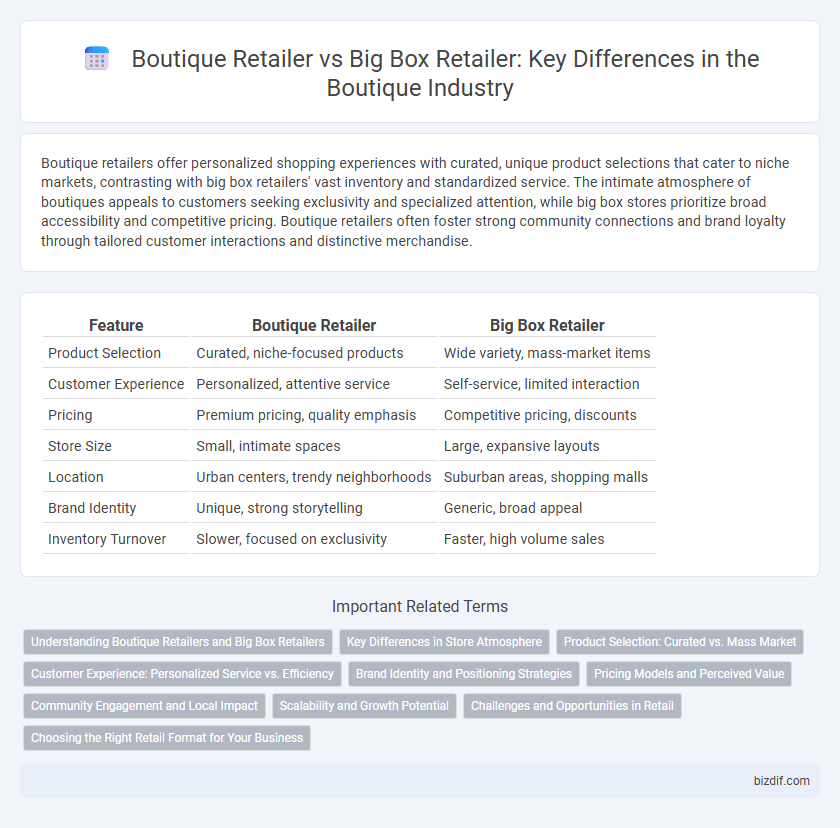Boutique retailers offer personalized shopping experiences with curated, unique product selections that cater to niche markets, contrasting with big box retailers' vast inventory and standardized service. The intimate atmosphere of boutiques appeals to customers seeking exclusivity and specialized attention, while big box stores prioritize broad accessibility and competitive pricing. Boutique retailers often foster strong community connections and brand loyalty through tailored customer interactions and distinctive merchandise.
Table of Comparison
| Feature | Boutique Retailer | Big Box Retailer |
|---|---|---|
| Product Selection | Curated, niche-focused products | Wide variety, mass-market items |
| Customer Experience | Personalized, attentive service | Self-service, limited interaction |
| Pricing | Premium pricing, quality emphasis | Competitive pricing, discounts |
| Store Size | Small, intimate spaces | Large, expansive layouts |
| Location | Urban centers, trendy neighborhoods | Suburban areas, shopping malls |
| Brand Identity | Unique, strong storytelling | Generic, broad appeal |
| Inventory Turnover | Slower, focused on exclusivity | Faster, high volume sales |
Understanding Boutique Retailers and Big Box Retailers
Boutique retailers specialize in offering curated, unique products that emphasize personalized customer experiences and niche markets, contrasting with big box retailers that provide a wide range of mass-produced goods at lower prices. Boutique stores often thrive on exclusivity, craftsmanship, and brand storytelling, attracting consumers seeking distinctiveness and higher-quality merchandise. Big box retailers leverage economies of scale, broad inventory, and competitive pricing to appeal to price-sensitive shoppers and drive high-volume sales.
Key Differences in Store Atmosphere
Boutique retailers emphasize a personalized and intimate shopping experience, featuring curated product selections and unique store designs that appeal to niche markets. In contrast, big box retailers prioritize spacious layouts with standardized display arrangements to accommodate high-volume inventory and mass-market appeal. The store atmosphere in boutiques fosters customer engagement through customized service, while big box stores focus on efficiency and broad accessibility.
Product Selection: Curated vs. Mass Market
Boutique retailers offer a carefully curated selection of products tailored to niche markets and customer preferences, emphasizing uniqueness and quality over quantity. Big box retailers provide a wide array of mass-market products designed to appeal to a broad customer base, often prioritizing volume and competitive pricing. This contrast shapes the shopping experience, with boutiques fostering personalized discovery and big box stores encouraging convenience and variety.
Customer Experience: Personalized Service vs. Efficiency
Boutique retailers excel in delivering personalized service, offering tailored product recommendations and a unique shopping environment that fosters strong customer relationships and loyalty. Big box retailers prioritize efficiency, providing a wide product selection at competitive prices with streamlined operations designed to handle high traffic and quick transactions. Customer experience in boutiques centers on individualized attention and ambiance, whereas big box stores emphasize convenience and speed.
Brand Identity and Positioning Strategies
Boutique retailers cultivate strong brand identity through personalized customer experiences, curated product selections, and exclusive offerings that emphasize uniqueness and craftsmanship. In contrast, big box retailers prioritize broad appeal and competitive pricing, leveraging economies of scale to position themselves as convenient one-stop shops with extensive inventory. Boutique positioning strategies revolve around niche markets and emotional connections, whereas big box retailers focus on mass-market penetration and operational efficiency.
Pricing Models and Perceived Value
Boutique retailers often use premium pricing models that emphasize exclusivity, unique product offerings, and personalized customer experiences, resulting in higher perceived value among niche customers. In contrast, big box retailers leverage economies of scale to offer lower prices and bulk discounts, appealing to price-sensitive consumers seeking convenience and variety. The perceived value in boutiques stems from craftsmanship and brand identity, whereas big box stores focus on affordability and accessibility.
Community Engagement and Local Impact
Boutique retailers often foster strong community engagement by supporting local artists, hosting neighborhood events, and tailoring their product selections to reflect regional tastes, which enhances local economic vitality. In contrast, big box retailers prioritize scale and efficiency, frequently leading to reduced local supplier involvement and limited personalized interaction with customers. The localized focus of boutique stores drives meaningful social connections and sustains small business ecosystems, creating a distinctive community impact that large chains typically cannot replicate.
Scalability and Growth Potential
Boutique retailers excel in personalized customer experiences and niche market targeting but face limitations in scalability due to higher per-unit costs and localized operations. Big box retailers benefit from economies of scale, extensive supply chains, and standardized processes, enabling rapid expansion and significant growth potential. Investing in technology and omni-channel strategies can help boutique retailers enhance scalability while maintaining their unique brand identity.
Challenges and Opportunities in Retail
Boutique retailers face challenges such as limited inventory and higher per-unit costs but benefit from personalized customer experiences and niche market appeal. Big box retailers leverage economies of scale and extensive product assortments, yet struggle with maintaining customer engagement and rapid adaptation to local preferences. Opportunities for boutiques include capitalizing on unique brand identity and agility in product curation, while big box retailers can enhance omnichannel strategies and incorporate localized merchandising to stay competitive.
Choosing the Right Retail Format for Your Business
Boutique retailers offer personalized customer experiences and unique product selections tailored to niche markets, contrasting with big box retailers' emphasis on high-volume sales and wide inventory variety. Choosing the right retail format depends on factors such as target audience, product differentiation, and brand positioning, with boutiques excelling in exclusivity and customer loyalty. Understanding operational costs, scalability potential, and competitive landscape helps businesses align their retail strategy for sustainable growth.
Boutique Retailer vs Big Box Retailer Infographic

 bizdif.com
bizdif.com